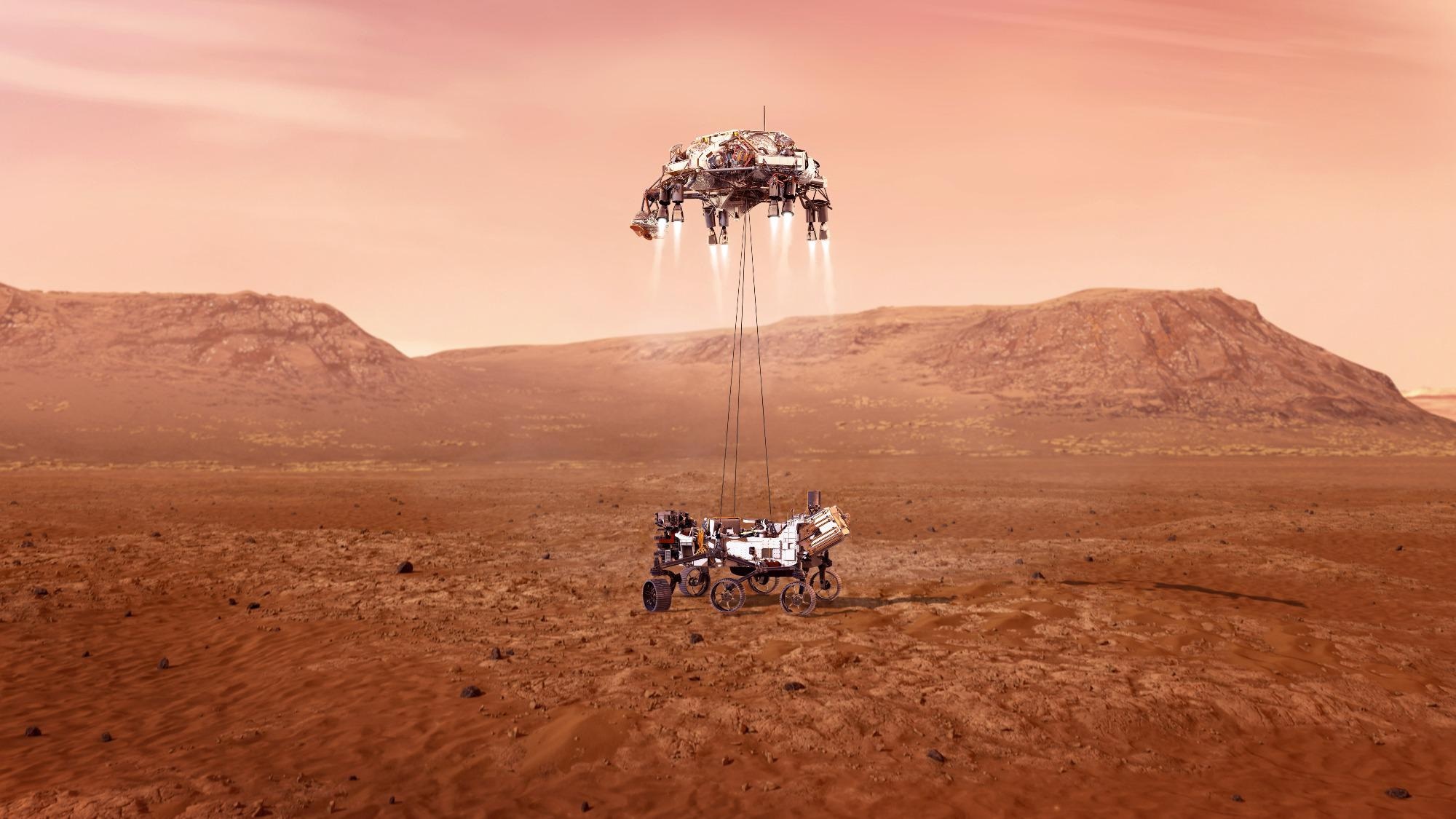
NASA's Perseverance rover successfully landed on Mars on 18 February 2021. Image Credit: NASA/JPL-Caltech
The 2020 Perseverance and ExoMars 2022 Mission
February 18 2021 was a big day for NASA. The Mars 2020 Perseverance rover successfully landed on Mars and started its search for signs of past life on the red planet. The rover will be characterizing the planet's geology, including collecting and identifying the composition of Martian rocks and dirt.
This mission is one of several missions over the next few years to deliver rovers to Mars. The next is the ExoMars 2022 project that will carry a rover capable of drilling 2 m into the planet’s ground to collect samples that can be analyzed in its on-board laboratory.
The Exomars2022 rover, named Rosalind Franklin, and the 2020 Perseverance have one piece of on-board equipment in common - a Raman spectrometer. This technology is a crucial tool in both missions and will help them achieve one of their key goals: analyzing the sulfate content in Martian soil.
Sulfates, or sulfur-based compounds, are thought to contain clues to how life on Earth started. Sulfur, along with carbon, oxygen, and nitrogen, is an element considered to be one of the key components of life, and sulfate levels in the atmosphere have varied over the Earth’s history. The historical reduction in sulfate levels is thought to coincide with a rise in oxygen production as life evolved into more familiar forms.1
As Mars and Earth were thought to have similar geochemical activity in the past, it is anticipated that many of the same sulfates found on Earth should also be present on Mars. However, while sulfates have been found in large quantities on Mars’s surface, more experimental data is needed to confirm which sulfates are present and extract information about Mars’s historical hydration levels and the possibility of supporting life.2
Raman Fingerprinting
Raman spectroscopy is an ideal tool for performing the microscopic sample analysis on the rock samples gleaned from the surface of Mars. A Raman spectrum contains a series of peaks that correspond to the different vibrational modes in a molecule. The position and linewidth of these peaks can be so unique to a system that they are considered a ‘fingerprint’ for the molecular species.
The analysis that can be performed with Raman spectroscopy goes beyond just simple chemical classification. For solid samples, the Raman spectrum reflects the material's crystallinity with a good degree of precision. Often, the Raman spectrum of a molecule will be much sharper and less convoluted than its infra-red equivalent as there tend to be fewer combination and overtone bands.
A Raman spectrometer consists of three main components: the light source, optics, and a detector. Narrow-bandwidth laser sources are commonly used to excite Raman spectroscopy samples to acquire spectra with excellent energy resolution. As large and complex chemical species may have large numbers of vibrational modes, an energy resolution of only a few numbers may be required to resolve them for unambiguous identification.
Optics are required to focus and shape the beam from the source to the detector. The complexity of the optical design depends on the particular configuration of the Raman spectrometer. Many of these need to be on moving translation stages for adjustment, such as for scanning the position of diffraction gratings to change the wavelength range focused onto the detector.
Spectrometers for Space
Designing instruments for rovers comes with many challenges. First, the instruments need to be incredibly robust to survive their journey to their destined planet. Secondly, the instruments need to be highly automated, as any adjustments, alignment, and measurement optimization will need to be performed remotely.
Rover-view: A Look at the Mars 2020 Rover, Perseverance
Video Credit: Smithsonian National Air and Space Museum/Youtube.com
The Raman spectrometers for Mars had another additional challenge to overcome. The terrain there is incredibly rocky, not to mention the challenges that come with the extreme temperatures on Mars, spanning -125 °C in its coldest climates to around 22 °C on its warmest sunny days.4
Any automated spectrometer relies on motorized translation stages to move gratings, adjust alignment, and focusing. In the spectrometers sent to Mars are Linkam stages, designed for geological applications that are designed to withstand temperatures of < -195 °C up to 1500 °C. The stages can also be temperature controlled for performing Raman measurements on samples that need to be heated for analysis.3
The Raman spectrometers on Mars will use the unique Raman signatures of different sulfate species to characterize Mars' geology, harvested by the coring drills attached to the rover's front. This mission represents a huge opportunity for understanding how sulfites are formed and in the development of robust and reliable Raman spectrometers with unparallel stability.
References and Further Reading
- Olson, K. R., & Straub, K. D. (2016) The role of hydrogen sulfide in evolution and the evolution of hydrogen sulfide in metabolism and signaling. Physiology, 31(1), 60–72. https://doi.org/10.1152/physiol.00024.2015
- Bishop, J. L., Darby Dyar, M., Lane, M. D., & Banfield, J. F. (2004) Spectral identification of hydrated sulfates on Mars and comparison with acidic environments on Earth. International Journal of Astrobiology, 3(4), 275–285. https://doi.org/10.1017/S1473550405002259
- Stages, Linkam (2021) Geological Applications [Online] https://www.linkam.co.uk/geologicalapplications (Accessed 11 February 2021).
- NASA - Mars Exploration Rovers. Rover Temperature Controls. [Online] Available at: https://mars.nasa.gov/mer/mission/rover/temperature/ (Accessed 19 February 2021).
Disclaimer: The views expressed here are those of the author expressed in their private capacity and do not necessarily represent the views of AZoM.com Limited T/A AZoNetwork the owner and operator of this website. This disclaimer forms part of the Terms and conditions of use of this website.